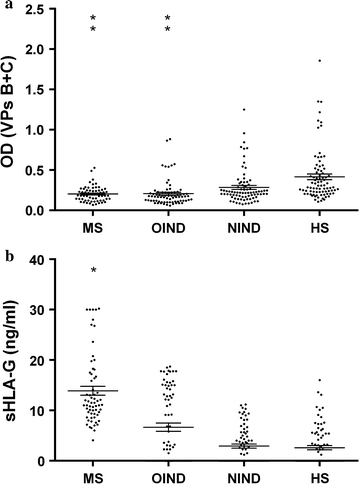Serum IgG against Simian Virus 40 antigens are hampered by high levels of sHLA-G in patients affected by inflammatory neurological diseases, as multiple sclerosis
- PMID: 27443345
- PMCID: PMC4957417
- DOI: 10.1186/s12967-016-0981-y
Serum IgG against Simian Virus 40 antigens are hampered by high levels of sHLA-G in patients affected by inflammatory neurological diseases, as multiple sclerosis
Abstract
Background: Many investigators detected the simian polyomavirus SV40 footprints in human brain tumors and neurologic diseases and recently it has been indicated that SV40 seems to be associated with multiple sclerosis (MS) disease. Interestingly, SV40 interacts with human leukocyte antigen (HLA) class I molecules for cell entry. HLA class I antigens, in particular non-classical HLA-G molecules, characterized by an immune-regulatory function, are involved in MS disease, and the levels of these molecules are modified according with the disease status.
Objective: We investigated in serum samples, from Italian patients affected by MS, other inflammatory diseases (OIND), non-inflammatory neurological diseases (NIND) and healthy subjects (HS), SV40-antibody and soluble sHLA-G and the association between SV40-prevalence and sHLA-G levels.
Methods: ELISA tests were used for SV40-antibodies detection and sHLA-G quantitation in serum samples.
Results: The presence of SV40 antibodies was observed in 6 % of patients affected by MS (N = 4/63), 10 % of OIND (N = 8/77) and 15 % of NIND (N = 9/59), which is suggestive of a lower prevalence in respect to HS (22 %, N = 18/83). MS patients are characterized by higher sHLA-G serum levels (13.9 ± 0.9 ng/ml; mean ± St. Error) in comparison with OIND (6.7 ± 0.8 ng/ml), NIND (2.9 ± 0.4 ng/ml) and HS (2.6 ± 0.7 ng/ml) subjects. Interestingly, we observed an inverse correlation between SV40 antibody prevalence and sHLA-G serum levels in MS patients.
Conclusion: The data obtained showed a low prevalence of SV40 antibodies in MS patients. These results seems to be due to a generalized status of inability to counteract SV40 infection via antibody production. In particular, we hypothesize that SV40 immune-inhibitory direct effect and the presence of high levels of the immune-inhibitory HLA-G molecules could co-operate in impairing B lymphocyte activation towards SV40 specific peptides.
Keywords: HLA-G; Multiple sclerosis; SV40.
Figures

References
-
- Mazzoni E, Pietrobon S, Masini I, Rotondo JC, Gentile M, Fainardi E, et al. Significant low prevalence of antibodies reacting with simian virus 40 mimotopes in serum samples from patients affected by inflammatory neurologic diseases, including multiple sclerosis. PLoS ONE. 2014;9:e110923. doi: 10.1371/journal.pone.0110923. - DOI - PMC - PubMed
Publication types
MeSH terms
Substances
LinkOut - more resources
Full Text Sources
Other Literature Sources
Medical
Research Materials

